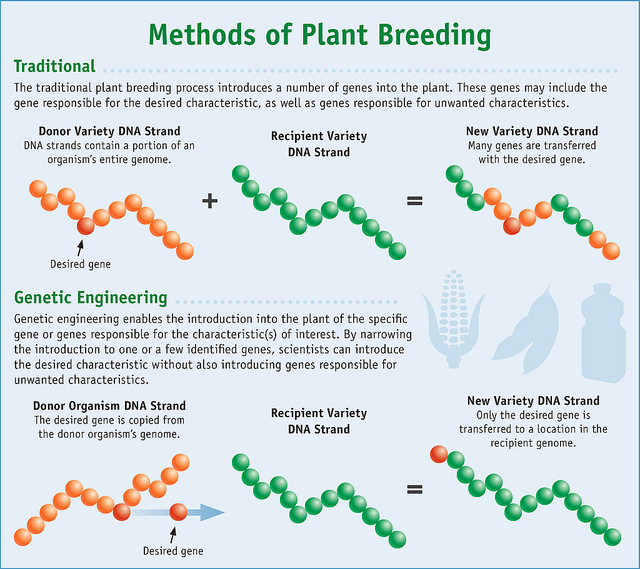Question
Answer
Expert response from Hope Hart
Foresight and Advocacy Lead, Global Seeds Product Safety, Syngenta
Tuesday, 27/05/2014 15:37
“GMO” stands for genetically modified organism. GMOs are used for a variety of purposes, such as to produce human insulin, vitamins, vaccines or enzymes used in cheeses, fermented beverages and starch products. GMO Answers is focused on GM crops for plant agriculture. Currently, eight crops are commercially available from GM seeds in the United States: corn, soybeans, cotton, canola, alfalfa, sugar beets, papaya and squash.

If you’re interested in learning more about how GM plants are created, check out the video below.
Alan McHughen, biotechnology specialist and geneticist, explains how we can be sure an inserted gene does what it is supposed to do in this post.
Both traditional plant breeding and genetic engineering involve altering the genes of a plant to make a better variety. Breeding involves random mixing of genes from two parent plants which results in a new variety that contains the desired characteristic and possibly other unwanted characteristics. A GM plant results from the direct transfer of an intended gene that gives the desired characteristic to the new variety. The graphic below discusses the differences between traditional plant breeding and genetic engineering.

If you have any additional questions, please ask!
Answer
Expert response from Hope Hart
Foresight and Advocacy Lead, Global Seeds Product Safety, Syngenta
Tuesday, 27/05/2014 15:37
“GMO” stands for genetically modified organism. GMOs are used for a variety of purposes, such as to produce human insulin, vitamins, vaccines or enzymes used in cheeses, fermented beverages and starch products. GMO Answers is focused on GM crops for plant agriculture. Currently, eight crops are commercially available from GM seeds in the United States: corn, soybeans, cotton, canola, alfalfa, sugar beets, papaya and squash.

If you’re interested in learning more about how GM plants are created, check out the video below.
Alan McHughen, biotechnology specialist and geneticist, explains how we can be sure an inserted gene does what it is supposed to do in this post.
Both traditional plant breeding and genetic engineering involve altering the genes of a plant to make a better variety. Breeding involves random mixing of genes from two parent plants which results in a new variety that contains the desired characteristic and possibly other unwanted characteristics. A GM plant results from the direct transfer of an intended gene that gives the desired characteristic to the new variety. The graphic below discusses the differences between traditional plant breeding and genetic engineering.

If you have any additional questions, please ask!
Video: GMO Answers at SXSW